Tons of Handspinning
After getting my latest installment of the Spunky Club fiber in the mail the other day, I spent two evenings spinning up the October and November fibers. They are gorgeous!
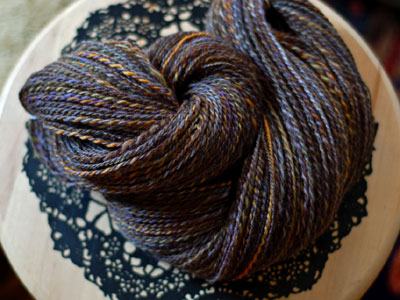
Spunky Eclectic Fiber Club October 2007 selection
“Goblin Eyes”
Romney wool
4 oz., 290 yards
15 wpi (sportish)
I spun this very quickly with some sort of modified worsted long draw technique, pulling back with the fiber hand instead of forward with the forward hand, smoothing a bit as I went. It’s nice and airy and has great drape. I finished this skein with only a warm soak.
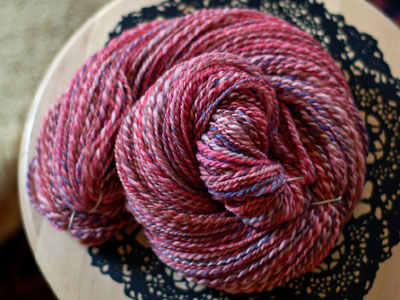
Spunky Eclectic Fiber Club November 2007 selection
“Pie for Everyone!”
Falklands wool (top)
3.5 oz. (there are leftovers), 180 yards
11 wpi (heavy worsted)
I spun this one in the same manner, though the wool wasn’t so long and slippery as the Romney, so didn’t go quite so fast. This one has more twist in it than the Romney, so it’s really springy. To finish this skein, I fulled and whacked*. It became very squishy and bouncy.
I noticed that the Falklands wool top was really directional, meaning that it was a lot nicer to spin from one end. I figured I’d take a photo and talk about it, since it’s not something I see mentioned often.
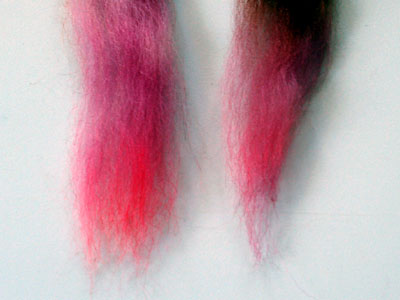
It’s easy to see that the two opposite ends of the same piece of top above are different. When I tore off a length of the top, one end came to a point and the other tore off pretty much straight across. This is because wool fibers are like human hair in that if it’s combed in one direction, there’s more resistance than if it’s combed in the other. When combed or carded, the fibers align themselves so there’s the least resistance possible. It’s often easier to draft fiber in this direction as well, which explains why that end pulls into a nice point. Sometimes, the difference when spinning isn’t very noticeable to me and sometimes it’s drastic. The pointy end is generally the end you want to spin from. Sometimes it’s hard to see the point, so give a spin and if your fiber is giving you any lip, tear the wool off and try from the other end and see if you notice a difference.
And knitting:
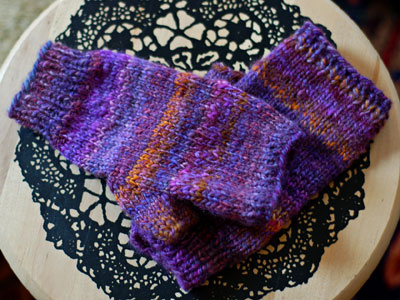
These are knit from the same yarn as the leg warmers. Hooray for leftovers!
They are Kolenya (PDF) fingerless mittens modified to lose the little crocheted chains between the fingers (stuff between my fingers and toes is annoying).
They used 2 oz. of bulky 2 ply BFL and Corriedale wool yarn, unknown yardage. It’s a great, simple pattern for a little bit of handspun. They’re nice and toasty!
* Fulled and whacked?? I think crimpy, shorter staple wools and other animal fibers benefit from rough treatment after spinning. I soak them in hot water with shampoo, dunking them in and out of the water a few times before letting them settle and sit 15 minutes or so. After draining that water, I then refill the sink with cold water and repeat the dunking and soaking. The water temperature change fulls the yarn and causes the crimp to go crazy and plump up. Yarns spun from crimpy wools like Merino bloom wonderfully with this treatment.
Fulling a long-stapled fiber yarn can cause it to felt to itself and get hard, so take care with those. I just soak them in warm water with shampoo and rinse. There’s a great article about this in the Summer 2007 Spin-Off with lots of pictures.
Whacking means that after the yarn has been washed, I squeeze the water out, grab one end of the skein, and beat it against the side of my bathtub, rotating the skein and repeating. This helps even out the twist in the yarn, and gets some of the water out, too. I do this with any skein that I think can handle the beating, which is everything but some novelties.
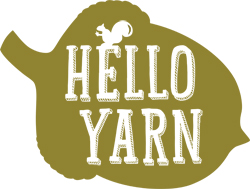
12 Responses to “Tons of Handspinning”
thanks for the lesson. i was wondering about the “fulled and whacked” part too.
All looks lovely. I especially love both the handspun.
Pretty! I especially love that top one.
I tried a similar dunk-and-whack technique once and it definitely worked and helped “even out” the yarn. I’ll have to try the warm watter thing – even though it seems sort of scary. ;)
watter? haha! It’s been a long day…
Thanks for the talk on the directionality (is this a word?) of fibers. I have read about it but didn’t know how to tell, except that one end of a top or roving was easier to draft from than the other. The pictures help so much as well as knowing that the directionality isn’t alway evident. I always wondered if I was doing something wrong because I couldn’t tell a difference in drafting from either end.
Thanks so much for the information you provide, and also for letting us see your beautiful spinning & etc.
One handy side effect of the whacking is that it also detangles skeins – especially if you didn’t put enough ties on the skein :)
so pretty. i can’t wait to see what you knit up with the Goblin yarn….
Ah, fulled and whacked! You are totally awesome and you rock. Thanks for all the useful info contained within this post.
Beautiful! And thanks for the lesson. I’m waiting for the arrival of my first wheel (a ladybug from Amy). At the moment I know NOTHING about spinning, but I can’t wait to jump in.
Yes, gorgeous! Your spinning is so lovely and the rich smoky color of the Goblin Eyes is entrancing. Ever since you taught me about the orientation of fibers in top at Yarn School, I’ve stopped having bizarre, unexplained fights with my wheel. You’re bringing peace to the world, one spinner at a time…
Gorgeous yarn, very informative post. Thanks!
I really appreciate your technical use of the term “whacking”. We need to submit that one to Random House.
:)